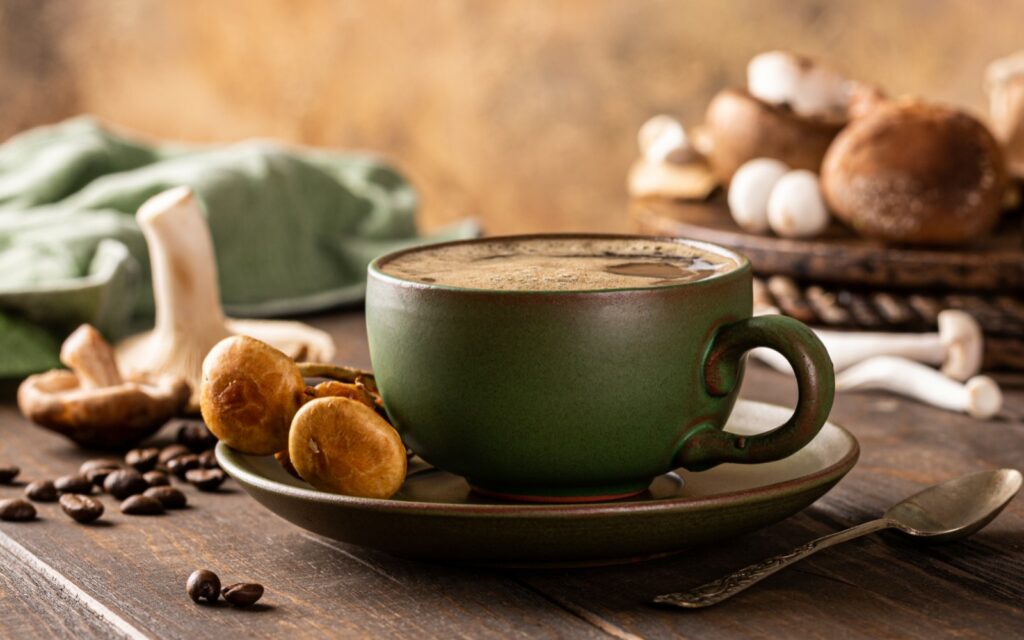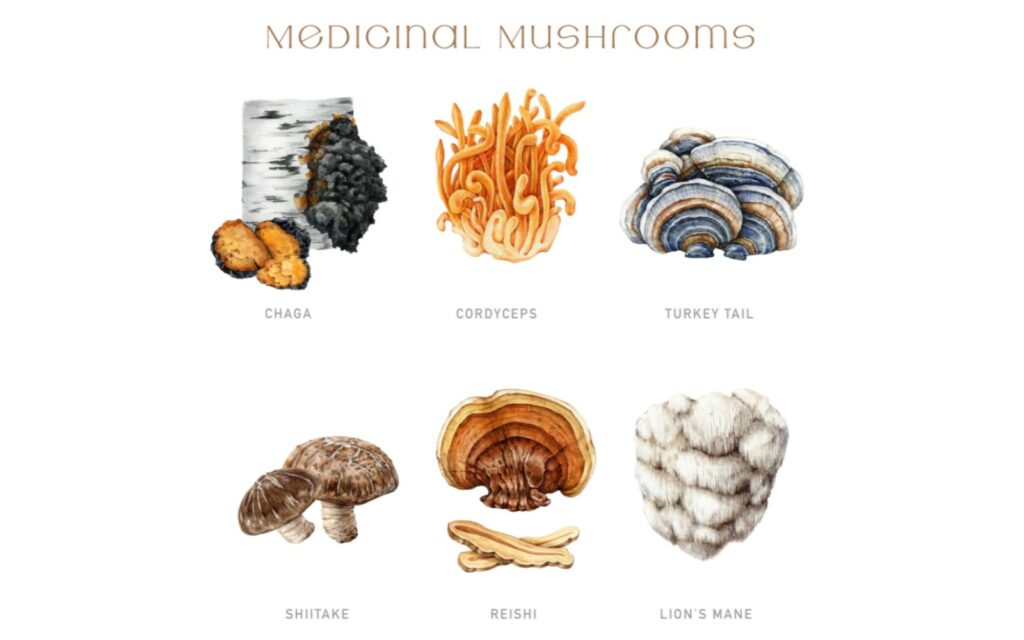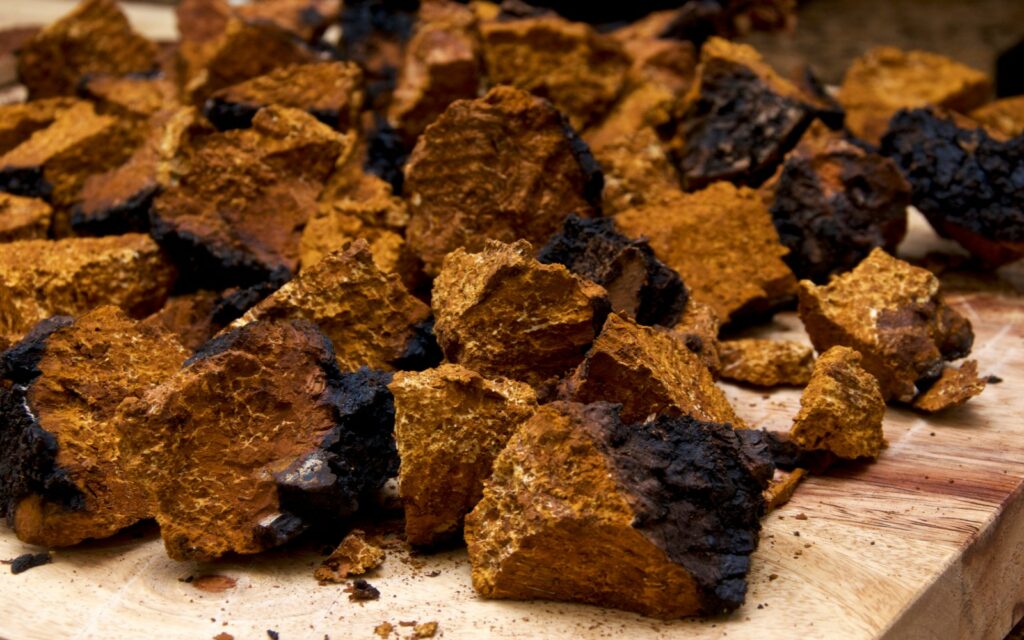
In this article, we’ll cover all aspects of Medical Mushrooms; what they are, their benefits, how to consume them and how did traditional cultures discover Medicinal Mushrooms.
What Are Medicinal Mushrooms?
Throughout history, traditional cultures have harnessed the potential health advantages of medicinal mushrooms. These mushrooms encompass bioactive compounds that contribute to different facets of well-being, such as immune function, cognitive health and overall vitality.
It’s important not to confuse medicinal mushrooms with psychoactive varieties. Medicinal mushrooms such as reishi, chaga, lion’s mane, and cordyceps offer nutritional advantages without containing the reality-altering compounds found in psychedelic mushrooms.

How Did Traditional Cultures Discover Medicinal Mushrooms?
Medicinal mushrooms’ benefits were initially uncovered by traditional cultures through careful observations in nature and the transmission of empirical knowledge across generations. People observed that specific mushrooms held nutritional value and exhibited therapeutic properties when ingested or applied externally.
With the passage of time, these mushrooms became fundamental components of traditional medical systems, including Traditional Chinese Medicine (TCM) and Ayurveda.

How Do I Take Medicinal Mushrooms?
What Parts To Take And Why:
Fruiting Body
The fruiting body, commonly referred to as the ‘mushroom cap’, represents the visible section of the mushroom and is regarded as the most potent and energetically dense part.
Fruiting bodies are renowned for their wide array of bioactive compounds and have long been linked to therapeutic advantages in Traditional Chinese Medicine (TCM) and other traditional healing systems.
In Traditional Chinese Medicine (TCM), fruiting bodies are typically characterized as having a more yang nature. They are frequently linked to qualities like warmth, activity and outward expression. Fruiting bodies are believed to possess a tonifying or strengthening effect on the body’s Qi, aiding in the enhancement of physical energy, vitality and resilience.
Mycelium
Mycelium consists of a network of filamentous threads that form the lower portion or the ‘roots’ of the mushroom.
Mycelium extracts may contain distinct bioactive compounds in comparison to the fruiting body. Mycelium is appreciated for its potential nutritional qualities and is frequently utilized for its beta-glucan content.
In Traditional Chinese Medicine (TCM), mycelium is generally linked to a more yin nature. It is characterized as being cooler, nourishing, and inwardly directed. Mycelium is believed to possess a nourishing and soothing effect on the body’s Qi and it is often thought to bolster the body’s capacity for regeneration, balance restoration and the promotion of internal harmony.
Bioactive Compounds
Mushrooms encompass an array of bioactive compounds, which are naturally occurring substances known for their potential positive effects on human health. Here are several noteworthy bioactive compounds commonly present in mushrooms:
• Polysaccharides: Polysaccharides, such as beta-glucans have been extensively studied for their immunomodulatory properties. This means they can help regulate and support the immune system. Polysaccharides enhance immune response, exhibit antioxidant activity and have potential anti-inflammatory effects.
• Terpenoids: Terpenoids are compounds that contribute to the unique flavours and aromas of mushrooms. They have been shown to have anti-inflammatory, antioxidant and anticancer properties.
• Phenolic Compounds: Phenolic compounds are antioxidants. They can help protect cells from damage caused by free radicals and deliver many other health benefits. Examples of phenolic compounds in mushrooms include phenolic acids, flavonoids and tannins.
• Amino Acids: Mushrooms are a source of amino acids. Amino acids are the building blocks of proteins. They play crucial roles in various biological processes that your body needs to function properly. Mushrooms are particularly rich in the amino acid called ergothioneine, which is known for its antioxidant properties.
• Vitamins and Minerals: Mushrooms contain several essential vitamins and minerals. They are a good source of B vitamins, including riboflavin (B2), niacin (B3) and pantothenic acid (B5). Mushrooms also contain minerals such as selenium, copper, potassium, and phosphorus.
• Other Compounds: Mushrooms may contain other bioactive compounds, including lectins, peptides, enzymes, and volatile compounds. These compounds contribute to the unique characteristics and potential health benefits of different kinds of mushrooms.
It’s crucial to recognize that the varieties and concentrations of bioactive compounds can differ from one mushroom species to another. Furthermore, the cultivation and preparation methods can influence these compounds. The bioactivity and health advantages associated with mushrooms remain a focal point of continual scientific investigation.
Ways To Consume Traditional Mushrooms
Culinary Use:
Incorporating medicinal mushrooms into your meals can not only enhance the flavours but also offer potential health advantages. They can be seamlessly integrated into dishes like soups, stews, stir-fries or sautés for a delightful culinary experience.
Dried Mushrooms:
Dried mushrooms present a convenient and adaptable choice. You can rehydrate them and employ them in recipes just like fresh mushrooms. To utilize dried mushrooms, simply soak them in water until they regain softness and flexibility.
You have the option to slice, dice or blend dried mushrooms and incorporate them into your culinary creations. Additionally, the soaking liquid can serve as a flavourful addition to dishes. Dried mushrooms have the advantage of an extended shelf life and can be easily obtained from stores or online retailers.
Regrettably, the quantity of mushrooms required for a therapeutic effect might be overwhelming for your taste buds. Also, some beneficial components may be less bioavailable in whole mushrooms since the cell walls may interfere with the absorption of these substances. This is when mushroom extracts may be more appropriate if the primary goal is to reap specific health benefits rather than consuming the mushrooms as food.
Mushroom Extracts:
Mushroom extracts represent concentrated versions of medicinal mushrooms. These extracts can be processed into powdered forms, providing a convenient method to access the advantages offered by the mushrooms.
Although extracts offer convenience, they may not encompass the natural equilibrium of compounds found in whole mushrooms. The quantity and variety of compounds extracted can vary depending on the method employed.
There are different types of extracts, each with its own characteristics:
• Water Extracts: These extracts are made by hot water extraction, either as tea or by boiling. The mushrooms are simmered in water. Water extracts primarily capture water-soluble compounds, including polysaccharides. They are often used for their immune-modulating and antioxidant properties.
• Alcohol Extracts: Alcohol extracts, also known as tinctures, are made by soaking the mushrooms in alcohol (such as ethanol). Alcohol extracts a broader range of compounds than water alone. including both water-soluble and alcohol-soluble constituents.
• CO2 Extracts: CO2 extraction is another method used to get bioactive compounds from medicinal mushrooms. It utilizes supercritical carbon dioxide (CO2) as a solvent to selectively dissolve and extract the desired compounds. CO2 extracts can be further processed into powders, making them convenient for consumption and easy to incorporate into various forms such as capsules, tablets or added to foods and beverages.
What Are Extract Ratios Such As 10:1 And 50:1 Numbers On The Supplement Labels?
Extract ratios serve as indicators of the concentration and potency of the extract relative to the initial mushroom material. For instance, a 10:1 extract ratio signifies that 10 grams of the original material (e.g., mushroom) have been condensed into 1 gram of extract. Higher ratios typically correspond to increased potency.
Adhering to the manufacturer’s recommended dosage is essential, or you can seek advice from a healthcare expert for personalized guidance regarding the suitable extract ratio and dosage tailored to your particular requirements.

Medicinal Mushrooms And Their Benefits
Reishi (Ganoderma Lucidum)
Recognized for: Immune support, relaxation, potential antioxidant and inflammation-balancing properties.
Bioactive Compounds/Nutrients: Polysaccharides (including beta-glucans), triterpenes (such as ganoderic acids), amino acids and other antioxidants.
Best Part to Take: Fruiting body.
Common Extract Ratio: 10:1 or 20:1.
Chaga (Inonotus Obliquus)
Recognized for: Immune modulation, potential antioxidant and inflammation-balancing effects and supporting healthy blood sugar levels.
Bioactive Compounds/Nutrients: Polysaccharides (including beta-glucans), melanin, phenolic compounds (such as betulinic acid).
Best Part to Take: Fruiting body.
Common Extract Ratio: 4:1 or 10:1.
Lion’s Mane (Hericium Erinaceus)
Recognized for: Cognitive support, nerve regeneration and potential memory and focus enhancement.
Bioactive Compounds/Nutrients: Polysaccharides (including beta-glucans), erinacines, hericenones and amino acids.
Best Part to Take: Fruiting body or mycelium.
Common Extract Ratio: 10:1 or 20:1 for fruiting body; 1:1 or 1:2 for mycelium.
Cordyceps (Cordyceps Sinensis)
Recognized for: Energy and stamina enhancement, potential adaptogenic effects and respiratory support.
Bioactive Compounds/Nutrients: Polysaccharides (including beta-glucans), cordycepin, cordycepic acid, and amino acids.
Best Part to Take: Fruiting body or mycelium.
Common Extract Ratio: 1:1 or 1:2 for mycelium; 8:1 or 10:1 for fruiting body.
Shiitake (Lentinula Edodes)
Recognized for: Immune support, cardiovascular health and potential inflammation-balancing and antioxidant effects.
Bioactive Compounds/Nutrients: Polysaccharides (including lentinan), beta-glucans, ergosterol (vitamin D precursor) and amino acids.
Best Part to Take: Fruiting body.
Common Extract Ratio: 4:1 or 10:1.
Maitake (Grifola Frondosa)
Recognized for: Immune enhancement, healthy blood sugar regulation and regulating cell growth.
Bioactive Compounds/Nutrients: Polysaccharides (including beta-glucans), ergosterol and amino acids.
Best Part to Take: Fruiting body.
Common Extract Ratio: 4:1 or 10:1.
Turkey Tail (Trametes Versicolor)
Recognized for: Immune modulation, healthy cell growth and well-being support.
Bioactive Compounds/Nutrients: Polysaccharides (including beta-glucans), protein-bound polysaccharide-K (PSK), ergosterol and phenolic compounds.
Best Part to Take: Fruiting body.
Common Extract Ratio: 4:1 or 10:1.

CollaGenius: The Best Medicinal Mushroom Supplement
CollaGenius is a groundbreaking powdered supplement that combines the potent benefits of medicinal mushrooms and collagen to optimize your overall health.
With highly concentrated extract ratios, this unique formula allows you to experience the incredible advantages of medicinal mushrooms without consuming extremely large quantities.
Each serving of CollaGenius is carefully crafted to deliver exceptional results. It features an impressive 50:1 extract ratio of Lion’s Mane fruiting body, providing a substantial 3000 mg dosage.
Additionally, it contains a 100:1 extract ratio of Chaga fruiting body at 2000 mg, 100:1 Cordyceps mycelium extract at 1000 mg, and 100:1 Reishi fruiting body extract at 1000 mg.
These extract ratios ensure that you receive a concentrated dose of bioactive compounds, including polysaccharides, triterpenes, and antioxidants, unlocking the full potential of these remarkable mushrooms.
The advantage of CollaGenius lies in its high extract ratios, which allow for maximum potency and efficacy. With the concentrated extracts, you don’t have to consume large quantities of mushrooms to reap their benefits.
This means you can enjoy the exceptional advantages of medicinal mushrooms conveniently and without overwhelming your daily routine.
Alongside the mushroom extracts, CollaGenius includes marine collagen at 500 mg and bovine collagen at 2500 mg, providing additional support for healthy skin, joints and bones.
Incorporating these medicinal mushrooms into your wellness routine can provide potential health benefits. However, it’s important to consult with healthcare professionals, especially if you have any underlying health conditions or are taking medications, to ensure their safety and appropriate use.



